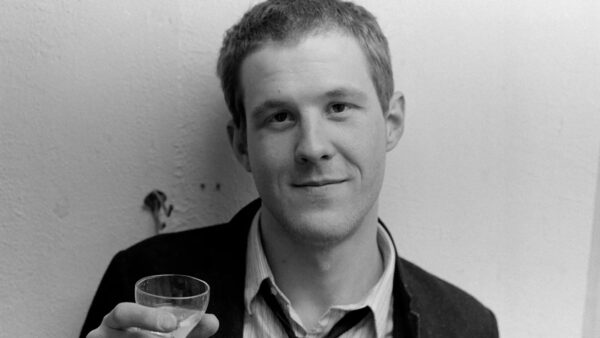Film Review: “Make Me Famous” – In Search of Edward Brezinski
By Melissa Rodman
Make Me Famous is not the portrait of a superstar like Jean-Michel Basquiat or Keith Haring; this protagonist is representative of the everyday angst, the struggle, the not-making-it, and the work that was produced regardless.
Make Me Famous, directed and edited by Brian Vincent. Several screenings scheduled this month, including one at the Weston Art & Innovation Center in Weston on March 13.

Artist Edward Brezinski in Make Me Famous. Photo: Wiki Common
The painter Edward Brezinski didn’t achieve the fame he craved. Still, despite his relative obscurity, he amassed a storied reputation. He once threw a glass of red wine at a prominent gallerist, Annina Nosei. He named his own gallery The Magic Gallery, “the stupidest name you could ever name a gallery,” remarked fellow painter Peter McGough. Most infamously, Brezinski “once ate a ‘mini-donut’ from a Robert Gober sculpture, later saying that he “mistook the art for catering,” according to Brezinski’s 2007 obituary in Artnet News. That donut, soaked in resin, sent Brezinski to the hospital.
These anecdotes invigorate Make Me Famous, a 2021 documentary that situates Brezinski in the ’80s East Village arts scene. This film is not the portrait of a superstar like Jean-Michel Basquiat or Keith Haring; this protagonist is representative of the everyday angst, the struggle, the not-making-it, and the work that was produced regardless. “The East Village was ours,” says artist David McDermott, one of the film’s many energetic interviewees. “‘The Little Rascals’ — where the kids get together, and they make it out of barnwood — that’s what it was.”

Edward Brezinski, Portrait of Nancy Reagan, c. 1983. hand tinted block print. Photo: Wiki Common
The documentary starts with images of the rundown neighborhood: crumbling buildings, sidewalks overflowing with trash, smashed car windows. Creativity flourished amid the wreckage. Brezinski lived, painted, and exhibited his art on East Third Street, across from a men’s shelter. He often made moody portraits, which are interspersed throughout the film as stills and also show up as set dressing behind interviewees. In Portrait of Nancy Reagan, a black, white, and red composition, Brezinski depicted the former first lady as a ghoulish figure, with a smudgy face and hands and strange scissor-blade legs. Another quick and very interesting montage compares Brezinski’s line-art Bianca (Bianca Jagger) to Andy Warhol’s silkscreen Marilyn Monroe. Indeed, both Brezinski and Warhol chose a captivating woman, pulled her image from the media, and reappropriated the likeness as an icon. But which artist’s name and work do you know?
Grainy home videos of Brezinski’s parties, captured by videographer Jim C, further transport the present-day viewer to the East Third Street of the ’80s. We watch an impassioned poetry reading by Miguel Pinero, for instance, and a rant by cultural critic Gary Indiana. The gatherings brought together the who’s who and the unknown, both groups necessary for the scene’s vibrancy. As Beauregard Houston-Montgomery wrote in May 1984 in the magazine East Village Eye, “Gallery owner Patrick Fox, Gary Indiana and Tony Heiberg popped in, as has everybody else in the downtown art scene, one Sunday or another.” Jim C’s footage archives the impermanence, the swirl of these madcap salons. Brezinski lingers in many frames, a spectral presence.
Make Me Famous‘s most intriguing narrative curve doesn’t come up until the middle of the movie. Brezinski’s death, reported only in the Artnet News obit, might not have happened. The film suggests that Brezinski had been irked by the rise of the artist/businessman, entrepreneurs like Damien Hirst and Jeff Koons. In the early ’90s, Brezinski left the US, first for Berlin, and ultimately for the French Riviera. Julie Jo Fehrle, a friend and fellow artist, recalls spotting Brezinski in Berlin; she visited the rat-infested building where he and others were squatting. But her contact with Brezinski didn’t last. “Do you think that Edward is capable of faking his death to the art world?” the film’s director, Brian Vincent, asks Fun Gallery founder Patti Astor in another interview. Astor laughs.
What ensues is a riveting quest along the Côte d’Azur to solve the mystery. Brezinski’s artist friends Marguerite Van Cook and James Romberger, who are partners, join the filmmakers in the search. No spoilers here regarding what is uncovered. Let’s just say that, for Brezinski, a person who so desired renown, who felt so hungry for people to see (and buy) his work, Make Me Famous offers a robust tribute.
Melissa Rodman is a journalist and critic based in New York.

